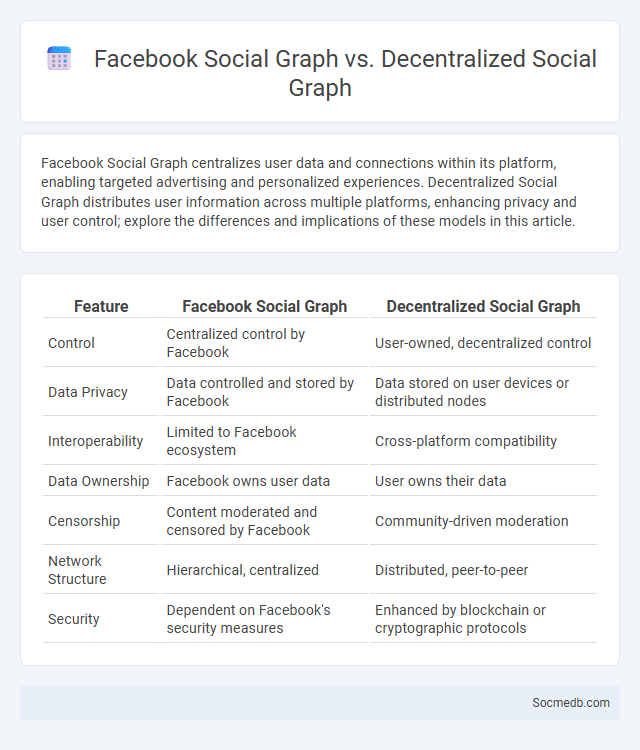
Photo illustration: Facebook Social Graph vs Decentralized Social Graph
Facebook Social Graph centralizes user data and connections within its platform, enabling targeted advertising and personalized experiences. Decentralized Social Graph distributes user information across multiple platforms, enhancing privacy and user control; explore the differences and implications of these models in this article.
Table of Comparison
| Feature | Facebook Social Graph | Decentralized Social Graph |
|---|---|---|
| Control | Centralized control by Facebook | User-owned, decentralized control |
| Data Privacy | Data controlled and stored by Facebook | Data stored on user devices or distributed nodes |
| Interoperability | Limited to Facebook ecosystem | Cross-platform compatibility |
| Data Ownership | Facebook owns user data | User owns their data |
| Censorship | Content moderated and censored by Facebook | Community-driven moderation |
| Network Structure | Hierarchical, centralized | Distributed, peer-to-peer |
| Security | Dependent on Facebook's security measures | Enhanced by blockchain or cryptographic protocols |
Understanding the Concept of Social Graph
The social graph represents the network of relationships and interactions among individuals on social media platforms, mapping connections like friendships, followers, and shared interests. Understanding your social graph helps optimize content distribution, targeting, and engagement by analyzing how information flows within your network. Leveraging insights from your social graph enhances your social media strategy, driving deeper connections and more effective communication.
Evolution of Social Graph Technologies
Social graph technologies have evolved from simple friend connections to complex, multi-dimensional networks that map relationships across platforms, enabling enhanced targeting and personalized content delivery. Advances in machine learning and big data analytics have transformed social graphs into dynamic, real-time models that support influencer identification, community detection, and behavior prediction. Emerging technologies like decentralized social graphs and blockchain integration are poised to increase user control over data privacy and network interoperability.
What is Facebook Social Graph?
Facebook Social Graph is a digital representation of the relationships and interactions between users, pages, and content on the Facebook platform. It maps connections such as friendships, likes, shares, and comments to understand social behavior and facilitate personalized experiences. This graph enables targeted advertising, content recommendations, and improved user engagement by analyzing the interconnected data points within the Facebook ecosystem.
Advantages and Limitations of Facebook Social Graph
Facebook Social Graph offers the advantage of mapping relationships and interactions, providing businesses valuable insights for targeted advertising and personalized user experiences. Your ability to leverage this data enhances connection building and social engagement but faces limitations due to privacy concerns and data access restrictions imposed by Facebook. Understanding these constraints is crucial for maximizing the Social Graph's potential while respecting user confidentiality and platform policies.
Introduction to Decentralized Social Graph
Decentralized social graphs empower You by distributing control of your social connections across multiple platforms rather than a single centralized network. This approach enhances privacy, data ownership, and interoperability, enabling your social identity and relationships to persist independently from any one service. By leveraging blockchain and peer-to-peer technologies, decentralized social graphs redefine how social media functions in a way that prioritizes Your autonomy and security.
Benefits of Decentralized Social Graph
Decentralized social graphs offer enhanced data privacy by giving users control over their personal information without relying on centralized platforms. Your connections and interactions become portable across multiple services, reducing dependency on any single social network and preventing data lock-in. This approach fosters greater transparency and resilience, empowering you to maintain ownership of your social identity and digital relationships.
Facebook Social Graph vs Decentralized Social Graph: Key Differences
The Facebook Social Graph is a centralized database that maps connections and interactions between users, enabling targeted advertising and personalized content. In contrast, a Decentralized Social Graph distributes data across multiple nodes, giving You greater control over privacy and data ownership. This fundamental difference affects how social relationships are managed and how secure user information remains in both systems.
Privacy and Data Ownership in Social Graphs
Protecting your privacy and ensuring data ownership in social graphs are critical as social media platforms collect vast amounts of personal information to map relationships and behaviors. You should be aware of how your data is used, who controls it, and the potential risks of unauthorized access or data breaches. Empowering yourself with privacy tools and understanding platform policies helps maintain control over your digital footprint within social networks.
Use Cases: Centralized vs Decentralized Social Graph
Centralized social graphs, exemplified by platforms like Facebook and Twitter, consolidate user data and connections on proprietary servers, enabling streamlined content delivery and targeted advertising but raising concerns about privacy and data control. Decentralized social graphs, powered by blockchain and protocols such as ActivityPub, distribute data ownership across users, enhancing privacy, censorship resistance, and interoperability among different platforms. Use cases for centralized social graphs include efficient community building and influencer marketing, while decentralized models support peer-to-peer networks, enhanced user sovereignty, and innovative identity management solutions.
Future Trends in Social Graph Development
Future trends in social graph development emphasize enhanced AI-driven personalization and privacy-focused data management, enabling more intuitive connections and user control. Integration of decentralized networks and blockchain technology aims to increase transparency and reduce dependency on centralized platforms. Advanced graph analytics will facilitate deeper insights into user behavior, boosting targeted marketing and community engagement.
 socmedb.com
socmedb.com